Gardens under glass
January 6th, 2010
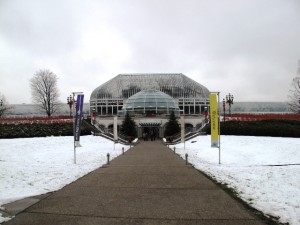
In a setting of snow on the last day of 2009, the Phipps Conservatory makes a grand statement
An amazing garden under glass, The Phipps Conservatory is a delightful destination in the heart of urban Pittsburgh.
I visited last week when the outdoor daytime weather averaged 20-degrees Fahrenheit.
But once we walked indoors, of course, the “season” changed. Blooms more likely to be seen in my Los Angeles backyard were thriving in the conservatory’s dozen-plus “rooms,” including the tropical-like Palm Court, Fern Room, Orchid room and Sunken Garden.
The Desert Room looked oh-so-familiar to me, with agaves, aoeniums, aloes and opuntias poking through the sand-colored gravel floor.
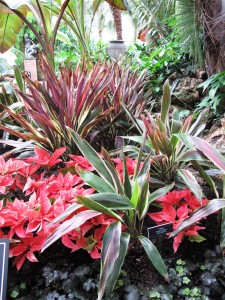
This was a new combination to me: Ti plants (Cordyline sp.) with Poinsettia
I visited on New Year’s Eve day and was delighted to learn that the Phipps actually remains open until 10 p.m. on New Year’s Eve, welcoming those more interested in a serene, candlelit celebration than louder festivities.
Right now, many of the plant displays here are dotted with glass sculptures by an artist named Hans Godo Frabel, who is know for his “realistic and otherworldly glass figures.”
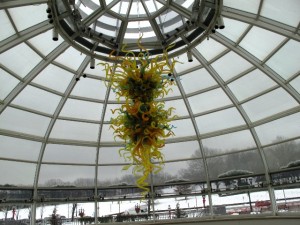
Chihuly's brilliant chandelier in mimosa yellow hangs from the ceiling of the new entry
Glass of a different sort was presented here in the past – the Dale Chihuly sort – and a few of his pieces remain in the permanent collection, which my photos show here.
My son Alex, who is 12, was very intrigued by Frabel’s alienlike glass creatures, as well as by his realistic glass flowers and salamanders. We took lots of “alien” photos.
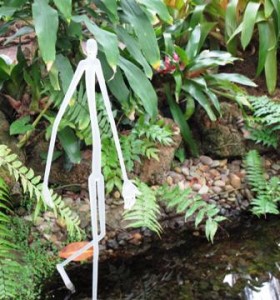
One of the eery glass aliens by Hans Godo Frabel
Fortunately, these disparate works of art were grouped together to present little stories in distinct wings of the conservatory. Otherwise I would have been completely confused.
In the 2000 book Crystal Palaces: Garden Conservatories of the United States, Anne S. Cunningham profiled the remaining major glass gardens. She wrote:
“Phipps Conservatory is a reminder of Pittsburg’s greatness in the time when Andrew Carnegie and Henry Phipps helped transform the American landscape with steel, steam engines, and civic philanthropy. Among his many contributions, Phipps (1839-1930) gave the city a conservatory “for public instruction and pleasure” in the newly developed Schenley Park.
When it was built, the Phipps Conservatory was the largest of its kind in the country. The shimmering Romanesque-style edifice made of steel, cypress, stone and glass reached 64 ft. tall and covered more than 43,000 square feet. It was originally filled with plants chosen at the World’s Colombian Exposition in Chicago. Writes Cunningham: “. . . the entire tropical plant display was shipped by train across the Midwest in time for the debut of the conservatory.”
From the height of fame to unfortunate neglect, this place barely survived subsequent decades. Sadly, the glorious conservatory fell into disrepair during the Depression. According to Cunningham: “by the 1930s, rats and weeds competed for space; a savage storm in 1937 damaged the big glasshouse and destroyed the greenhouses in back. By 1940, WPA crews had reconstructed the production houses, but the conservatory continued to suffer from natural deterioration and inconsistent community support.”
The Phipps’s renaissance came in 1993 when a private foundation purchased it and began to restore and revive the grand garden under glass. The Phipps seems to have come full circle with the 2009 highlight of hosting President and Mrs. Obama and the G-20 summit last September. The conservatory was the site of the opening dinner and reception for the world’s leaders. How wonderful that a garden was the backdrop for this powerful gathering.
The rebirth of this grand conservatory is indeed cause for celebration. Here are some impressions from our visit last Thursday:
- Another unusual holiday combo: Poinsettias, ivy and flowering plectranthus
- A Chihuly piece entitled “Cattails”
- Oh how we envy the towering tree ferns
- This is elegant: a red poinsettia + white orchid + green maidenhair fern in a black estate urn
- A snow-white phalenopsis orchid
- For some reason I loved this poinsettia’s green-red marbling
- A delicate orchid, photographed by Alex w/the macro feature
- Gorgeous and inspiring – a hanging tillandsia “ball”
- A delicate little flower, in sweet pea colors, blooming on a tillandsia
- another gem in the Orchid Room
- Paphiopedilum aka beautiful orchid
- True confessions: I don’t recall the name of this hothouse plant, but I sure love its stripy foliage









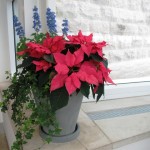
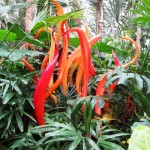
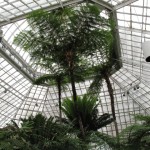
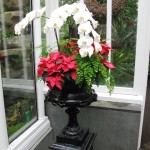
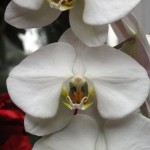
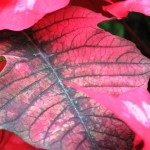
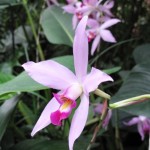
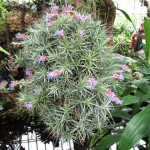
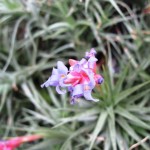
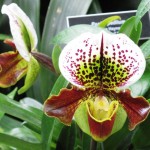
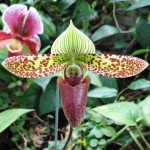
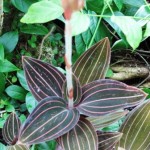
January 7th, 2010 at 4:53 am
I am fortunate & spoiled. Having been to many states & countries I see how alike public greenhouses have become. Even Kew was building a sky walk last time I was there.
Chihuly & Frabel are fabulous but ubiquitous at public greenhouses.
A decade ago there was greater diversity in style. It’s as if public greenhouse directors are reading the same newsletter. Fine if you are local and are seeing only 1 public greenhouse. As most people are. (Already admitted I’m spoiled.)
There is an interesting public greenhouse display in Las Vegas…………changes regularly.
A desire? More local/regional flavor amongst the international repetition.
Garden & Be Well, XO Tara
January 7th, 2010 at 8:50 am
Hi Debra,
That little plant whose name eludes you is Ludisia discolor, commonly known as jewel orchid. It is a terrestrial (it grows in soil) orchid native to Malaysia, Indonesia and Burma. In their natural environment, these orchids can be found growing on the forest floor. They have gorgeous velvety deep burgandy foliage with pinky- red veins. Sprays of exquisite, tiny white flowers open any time from December to February and like most orchids, last a month or more.
Veronica
.-= Veronica Sliva´s last blog ..Hong Kong…naturally =-.
January 13th, 2010 at 2:04 am
Great post! I love that mixture of exotic plants with exotic artworks. Reading it reminded me that I had for some time been intending to write about Chihuly at Kew Gardens- so this spurred me on to do it! I have linked it to your site and hope you are happy with that…
.-= gillian ware´s last blog ..Chihuly at Kew Gardens, 2005/6 =-.
March 14th, 2010 at 7:19 pm
nice pics of exotic plants
.-= Cyprus Girl´s last blog ..Visa and Passport for Travelers to Cyprus =-.